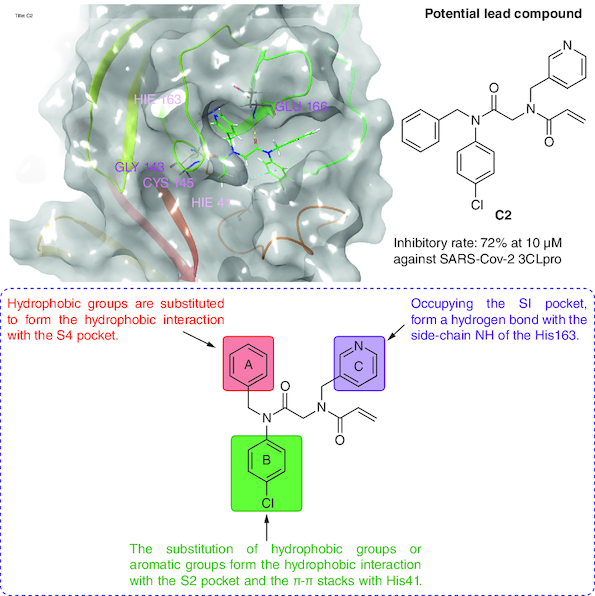Abstract
Background: The epidemic caused by SARS-CoV-2 swept the world in 2019. The 3C-like protease (3CLpro) of SARS-CoV-2 plays a key role in viral replication, and its inhibition could inhibit viral replication. Materials & methods: The virtual screen based on receptor–ligand pharmacophore models and molecular docking were conducted to obtain the novel scaffolds of the 3CLpro. The molecular dynamics simulation was also carried out. All compounds were synthesized and evaluated in biochemical assays. Results: The compound C2 could inhibit 3CLpro with a 72% inhibitory rate at 10 μM. The covalent docking showed that C2 could form a covalent bond with the Cys145 in 3CLpro. Conclusion: C2 could be a potent lead compound of 3CLpro inhibitors against SARS-CoV-2.
Graphical abstract

Novel scaffolds of 3C-like protease (3CLpro) inhibitors as lead compounds against SARS-CoV-2 were identified.
Multiple pharmacophore models were used to explore the chemical space of the inhibitors of 3CLpro.
The compound C2 had the best inhibitory rate among its derivatives.
C2 could be a potential covalent inhibitor of 3CLpro indicated by covalent docking.
Author contributions
Y Yan, H Liu, D Wu, Z Gu, W Guo, H Yao, K Lin, X Li conceived the main theme of the work and ensured that the study was rationally valid. Y Yan, K Lin and X Li wrote this manuscript and developed the original hypothesis for the work. All authors edited the final manuscript. All authors read and approved the final manuscript.
Financial disclosure
This work was supported by National Natural Science Foundation of China (81903439). The authors have no other relevant affiliations or financial involvement with any organization or entity with a financial interest in or financial conflict with the subject matter or materials discussed in the manuscript apart from those disclosed.
Competing interests disclosure
The authors have no competing interests or relevant affiliations with any organization or entity with the subject matter or materials discussed in the manuscript. This includes employment, consultancies, honoraria, stock ownership or options, expert testimony, grants or patents received or pending, or royalties.
Writing disclosure
No writing assistance was utilized in the production of this manuscript.
Declaration of competing interest
The authors declare that they have no known competing financial interests or personal relationships that could have appeared to influence the work reported in this paper.
